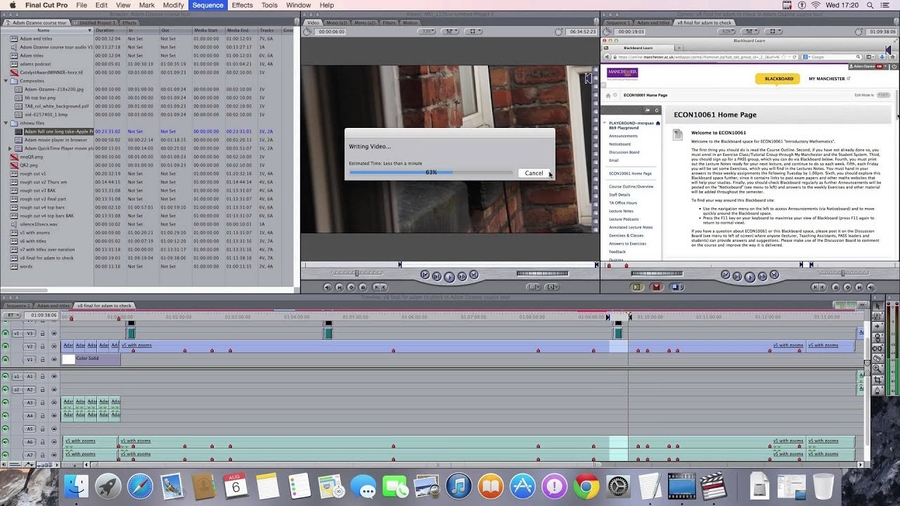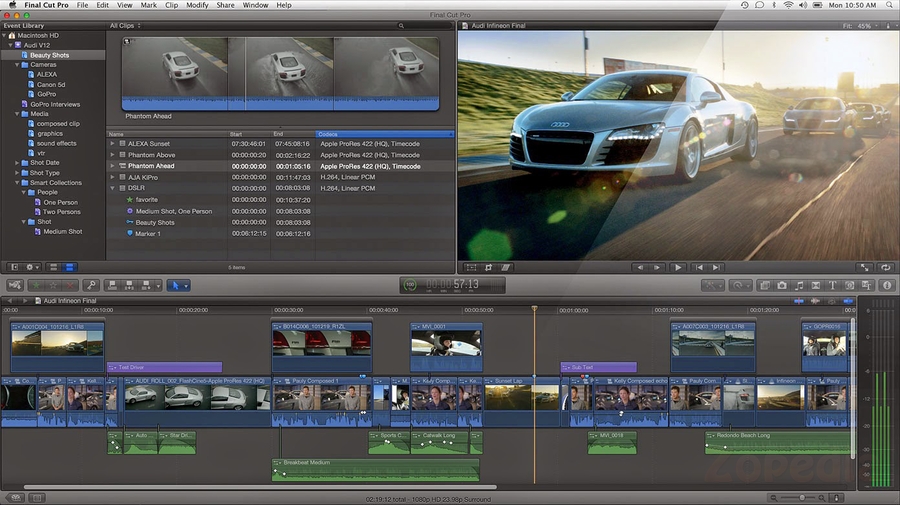Final cut pro 7 mac kickass
Dating > Final cut pro 7 mac kickass
Download links: → Final cut pro 7 mac kickass → Final cut pro 7 mac kickass
Improved Markers: You can now color-code your clip and sequence markers, search and jump to them, and add information to them as the clip plays, and more. ProRes 422 LT If you know the regular ProRes 422, you like it, you use it, then think of this as ProRes 422 on a bandwidth diet. However, the version downloaded on these torrent sites come with added extra, compressor.

Any idea or suggestion is welcome to leave below. However, you should keep in mind that there are numerous risks involved in doing so. Поддержка видео виртуальной реальности с обзором 360° также появилась в сопутствующих приложениях Apple для Final Cut Pro: Motion и Compressor. This has been possible in the past with an AJA Io or similar device, or with a second Mac and a DV hardware codec, but now it is possible with no additional hardware from within Final Cut Pro 7. New versions of Apple pro video applications — including , Motion 5, and 4 — are compatible with macOS High Sierra. How small is that? Also the Gatekeeper problem has not ocurred with pkg, although i am not 100 % sure about this, but i did not hear complains about that since i have been uploading in pkg. Footage can start importing as soon as media is connected, which opens the door to faster, more efficient workflows as well as potentially automated workflows. It has been more than two long years since Apple released , its flagship pro-level nonlinear video editing app. To download, click on the download torrent located on the right side of the screen.
And of course, their download speed has to at least match that—they have to be able to catch as fast as you can pitch. However, you should keep in mind that there are numerous risks involved in doing so. RIP Final Cut Pro 7 This is it, people.

Final Cut Pro X + Motion 5 + Compressor 4 (2011) Английский скачать торрент бесплатно - In order to get you up to speed, here is the official announcement by Apple: Dear …: Our records show that you may be using applications included in Final Cut Studio. The interface of Apple Final Cut Pro 10 Crack Mac feels much more spacious, as many of the buttons that were arranged across the centre of the interface have been repositioned around the outside.

It has been more than two long years since Apple released , its flagship pro-level nonlinear video editing app. While there are a few extremely sexy new features in Final Cut Pro 7— among them new ProRes flavors, iChat Theater, and Easy Export that will attract lots of attention—the main focus of this new version seems to be enhancing stability, speed, and productivity. New ProRes flavors ProRes, a high-definition lossy video compression format developed by Apple for use in post production, was introduced in 2007 with Final Cut Pro 6 FCP. In the most compelling new feature of this release, Apple builds on the success of its excellent ProRes codec family by adding three new flavors: ProRes 4444, ProRes 422 LT , and ProRes 422 Proxy. ProRes 4444 is designed for highest end work or compositing with alpha channel. The LT version is for lightweight deliverables, such as broadcast, while the 422 Proxy is specifically for offline editing. ProRes 4444 For video editors like me who try to push FCP as far as it can go, there is now a ProRes codec for working with high end formats think HDCAM SR or Redcode or for higher quality when rendering from FCP or other programs, specifically compositing applications. ProRes 4444 supports either the traditional video color space or RGB at full 4:4:4 color sampling, at up to 12 bits per pixel according to Apple. Wait, what is the fourth four for? It is for your alpha channel, and yes, Virginia, they did it right and it does have 10 bits per pixel as well. ProRes 422 LT If you know the regular ProRes 422, you like it, you use it, then think of this as ProRes 422 on a bandwidth diet. Turns out a lot of broadcast equipment is built around 100 megabits per second pipelines—Panasonic started it with the Varicam and its DV100 aka DVCPRO HD codec, and continued with its AVC-Intra codec, both of which run at a maximum data rate of 100 megabits per second. So a lot of folks had their digital plumbing set up for 100 megabits per second, and regular ProRes 422, which can run up to 145 megabits per second for 1080i60 footage, could gum up the works since it was nearly 50 percent larger than the anticipated data rate. So along comes ProRes 422 LT. Sports and news editing for broadcast, for instance, will love this codec, since the decrease in quality will never be noticed by the time is it is compressed even further and sent out to air. ProRes 422 Proxy The other ProRes codecs are fine for online editing at final quality for various quality expectations, but what about for offline editing? That's where ProRes 422 Proxy comes in. It is still full frame, 10 bit, and 4:2:2, but is much more heavily compressed. It takes the data rate all the way down to 45 megabits per second for 1080i60 video—or a touch over 5. How small is that? Most impressive, but how does it look? It is clearly of inferior quality, compared with the other ProRes codecs or DVCPRO HD, but this is for offline editing, not finishing work. Easy Export Easy Export will probably be the favorite new feature of most editors for its ease of use and time savings. There are three new aspects of the Easy Export feature that significantly enhance productivity and flexibility. You can assign multiple settings right from this interface, as well. You can, for instance, do any of the following or more with the click of a button: Post directly to MobileMe upon completion of compression; import into iTunes to sync to AppleTV, iPod or iPhone; publish directly to YouTube; burn a DVD or Blu-ray disc directly from this interface without going to DVD Studio Pro; or create your own post render process within Compressor, even launching Automator scripts. Then of course, you can make them available via the Share interface. That's right—you can burn a Blu-ray disc directly from within Final Cut Pro 7. The downside is that Apple as of this writing still doesn't sell a Blu-ray capable SuperDrive, so you have to get a third-party drive. You can, however, burn AVCHD Blu-ray content to a standard recordable DVD disc in your SuperDrive via Share, and that will play in a Blu-ray player. DVDs and Blu-ray have a limited slate of templates to choose from, but you can at least assign custom graphics with alpha for background, logo, and title graphics, and even generate a chapter menu. Another significant catch—this is the only Blu-ray support offered in the entire Final Cut Studio suite. DVD Studio Pro does not support Blu-ray in any fashion, and gets only the smallest of increments—from version 4. It does not support Blu-ray authoring, encoding, or burning. Easy Export is powerful, convenient, and useful, but that is the extent of Blu-ray support in this release. Final Cut Pro even takes advantage of Compressor clusters to accelerate the process. What if you could send the live output of your edit session to someone over iChat? This has been possible in the past with an AJA Io or similar device, or with a second Mac and a DV hardware codec, but now it is possible with no additional hardware from within Final Cut Pro 7. Of course, how well this works is entirely dependent on how fast your outbound internet connection is. And of course, their download speed has to at least match that—they have to be able to catch as fast as you can pitch. The clever new iChat Theater capability allows you to share the Canvas or Browser as a video feed for a video chat over iChat. This is the view that the editor guy in the hat sees. New Change Speed tools A new interface for the Change Speed window lets you set Ease In and Ease Out and has an option that lets you keep the timeline from rippling so you can doodle without pushing the rest of your timeline further down the sequence, which would mess up your audio sync. Also, a new interface element gives you keyframes in the timeline and a graphic display of how stretched your video is in time. You can either drag stretch for constant speed changes, or set keyframes for variable speed changes, right in the timeline. However, you can always run the clip through Motion for more accurate control and smoother results. More fixes and features Native AVC-Intra Support: Final Cut Pro 7 now supports native editing of this format—you can import it and edit it directly in its native file format as it was captured , rather than having to import and wait for it to transcode to ProRes before it is editable in Final Cut Pro. Native support also includes RT Extreme acceleration for real time transitions and effects. Alpha Transitions: Alpha transitions are scene transitions that use an animated graphic element with a matte or alpha channel, thus the name to do a wipe between two shots. New Timecode window: Previously only available as a third-party option, now you can display a resizable floating window that shows the timecode. This is ideal for that client on the couch in the back of the room. Improved Markers: You can now color-code your clip and sequence markers, search and jump to them, and add information to them as the clip plays, and more. Automatic Transfer: XDCAM and P2 footage now optionally copies to designated scratch directories as soon as the media is detected, and custom metadata can be added automatically via a new Log and Transfer window. Footage can start importing as soon as media is connected, which opens the door to faster, more efficient workflows as well as potentially automated workflows. New Redcode Log and Transfer options: When importing Redcode via Log and Transfer, you can transcode to any of the ProRes flavors on import, or just import it as native. But there are no new options for cropping or scaling which I had hoped to see, nor will the 2K layer of 4K native files play back in real time in Final Cut Pro 7. Footage shot in the default 4K 16:9 will come in at a nonstandard for video size of 2048 by 1152, and there are no options in Final Cut to scale this to 1920 by 1080 ProRes. Similarly, if 4K footage is shot in the 2:1 aspect ratio, no provision for cropping or letterboxing to fit into 1920 by 1080 ProRes is provided by Apple. This can be done with Red provided tools, however. This version of Final Cut Pro includes much improved closed captioning support, the ability to globally change transitions or cherry pick the ones you want to change in bulk , improved tabs color coding and other improvements , trackpad multi-touch gesture support for timeline navigation, and a new version of Cinema Tools for working with file-based workflows like image sequences and Redcode footage. This is a huge improvement over prior versions, but not clearly documented within Cinema Tools.
Last updated